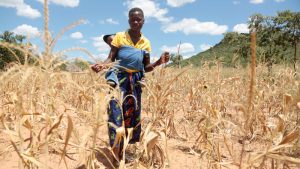
Last year’s drought was one of the worst on record – shrivelling maize in farmers’ fields. (Aaron Ufumeli/TNH)
HARARE – Nearly seven million people across Zimbabwe are at risk of going hungry as a result of successive droughts and rising inflation. According to the Famine Early Warning Systems Network, Zimbabwe is at a “Phase 3” food crisis, meaning that acute malnutrition is widespread.
“Families have run out of options to put food on their tables,” said Dorrett Byrd, Catholic Relief Services’ (CRS) regional director for Southern Africa. “There have been extensive crop failures and we’re seeing families who have depleted their food supplies. At the same time, families’ savings have been wiped out because of inflation.”
Over the last five years, Zimbabwe has been plagued by recurrent droughts and dry spells. In a country where more than half the population survives on small-scale farming, that means that families have been forced to cope by using their savings or selling off household assets to buy food. According to figures from the United Nations office for the Coordination of Humanitarian Affairs (OCHA), approximately 7 million people in Zimbabwe are in urgent need of food assistance.
“To cope with what’s happening here, a growing number of young people are migrating from rural areas to urban areas to find jobs, or are leaving the country altogether,” Byrd said. “Migrating parents often leave their young children behind with grandparents who struggle to provide for them.”
What’s more, tens of thousands of families are still recovering from Cyclone Idai, which wreaked havoc on harvests. To make matters even worse, families are contending with severe inflation, making their economic situation even more precarious.
In addition to a variety of multi-sectoral assistance programs, CRS is training Zimbabwean farmers to use climate-smart farming techniques, such as improved soil and water conservation. CRS is also providing farmers with drought-resistant crops and livestock. In addition, CRS is working with the government to send text messages to farmers to warn them about potential risks to their crops.
The humanitarian situation in Zimbabwe is expected to further deteriorate in the months ahead, with projections for poor rainfall and harvests continuing into 2020.
Beyond the deteriorating conditions in Zimbabwe, CRS’ field experts are also warning of a worsening hunger crisis in Lesotho, Zambia, Mozambique, Madagascar and Malawi. According to the Food and Agriculture Organization (FAO), more than 45 million people across Southern Africa are currently facing food insecurity.
“This area of the world needs help and it needs help now. The droughts have gotten longer and more intense because of climate change and these communities aren’t going to be able to address it without global assistance,” Byrd said. “There is an urgent need globally to take definitive action that will slow down, stop, or reverse climate change. We hope the economic situation improves soon, but if climate change is not addressed, countries like Zimbabwe will continue to suffer.”
Post published in: Agriculture

